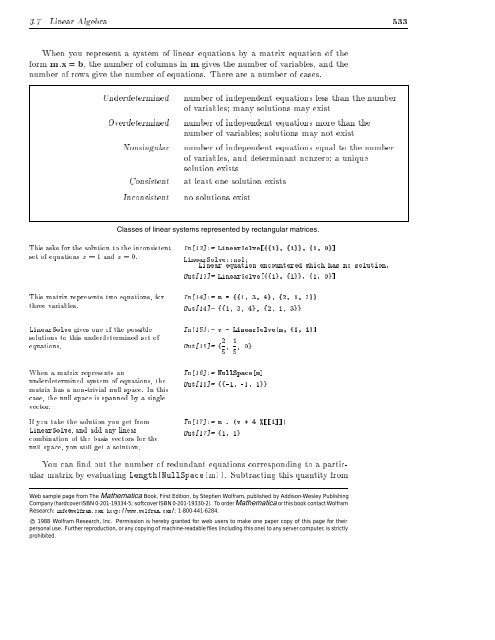3.7.8 Solving Linear Systems
3.7.8 Solving Linear Systems
3.7.8 Solving Linear Systems
You also want an ePaper? Increase the reach of your titles
YUMPU automatically turns print PDFs into web optimized ePapers that Google loves.
3.7 <strong>Linear</strong> Algebra 533<br />
When you represent a system of linear equations by a matrix equation of the<br />
form m:x = b, the number of columns in m gives the number of variables, and the<br />
number of rows give the number of equations. There are a number of cases.<br />
Underdetermined<br />
Overdetermined<br />
Nonsingular<br />
Consistent<br />
Inconsistent<br />
number of independent equations less than the number<br />
of variables many solutions may exist<br />
number of independent equations more than the<br />
numberofvariables solutions may not exist<br />
number of independent equations equal to the number<br />
of variables, and determinant nonzero a unique<br />
solution exists<br />
at least one solution exists<br />
no solutions exist<br />
Classes of linear systems represented by rectangular matrices.<br />
This asks for the solution to the inconsistent<br />
set of equations x =1andx =0.<br />
In[13]:= <strong>Linear</strong>Solve[{{1}, {1}}, {1, 0}]<br />
<strong>Linear</strong>Solve::nsl:<br />
<strong>Linear</strong> equation encountered which has no solution.<br />
Out[13]= <strong>Linear</strong>Solve[{{1}, {1}}, {1, 0}]<br />
This matrix represents two equations, for<br />
three variables.<br />
In[14]:= m = {{1, 3, 4}, {2, 1, 3}}<br />
Out[14]= {{1, 3, 4}, {2, 1, 3}}<br />
<strong>Linear</strong>Solve gives one of the possible<br />
solutions to this underdetermined set of<br />
equations.<br />
When a matrix represents an<br />
underdetermined system of equations, the<br />
matrix has a non-trivial null space. In this<br />
case, the null space is spanned by a single<br />
vector.<br />
If you take the solution you get from<br />
<strong>Linear</strong>Solve, and add any linear<br />
combination of the basis vectors for the<br />
null space, you still get a solution.<br />
In[15]:= v = <strong>Linear</strong>Solve[m, {1, 1}]<br />
2 1<br />
Out[15]= {-, -, 0}<br />
5 5<br />
In[16]:= NullSpace[m]<br />
Out[16]= {{-1, -1, 1}}<br />
In[17]:= m . (v + 4 %[[1]])<br />
Out[17]= {1, 1}<br />
You can nd out the number of redundant equations corresponding to a particular<br />
matrix by evaluating Length[NullSpace[m]]. Subtracting this quantity from<br />
Web sample page from The Mathematica Book, First Edition, by Stephen Wolfram, published by Addison-Wesley Publishing<br />
Company (hardcover ISBN 0-201-19334-5; softcover ISBN 0-201-19330-2). To order Mathematica or this book contact Wolfram<br />
Research: info@wolfram.com; http://www.wolfram.com/; 1-800-441-6284.<br />
c 1988 Wolfram Research, Inc. Permission is hereby granted for web users to make one paper copy of this page for their<br />
personal use. Further reproduction, or any copying of machine-readable files (including this one) to any server computer, is strictly<br />
prohibited.
















